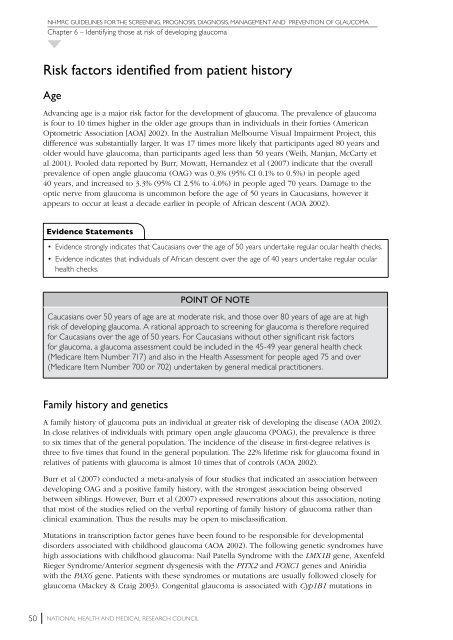NHMRC Glaucoma Guidelines - ANZGIG
NHMRC Glaucoma Guidelines - ANZGIG
NHMRC Glaucoma Guidelines - ANZGIG
You also want an ePaper? Increase the reach of your titles
YUMPU automatically turns print PDFs into web optimized ePapers that Google loves.
<strong>NHMRC</strong> GUIDELINES FOR THE SCREENING, PROGNOSIS, DIAGNOSIS, MANAGEMENT AND PREVENTION OF GLAUCOMA<br />
Chapter 6 – Identifying those at risk of developing glaucoma<br />
Risk factors identified from patient history<br />
Age<br />
Advancing age is a major risk factor for the development of glaucoma. The prevalence of glaucoma<br />
is four to 10 times higher in the older age groups than in individuals in their forties (American<br />
Optometric Association [AOA] 2002). In the Australian Melbourne Visual Impairment Project, this<br />
difference was substantially larger. It was 17 times more likely that participants aged 80 years and<br />
older would have glaucoma, than participants aged less than 50 years (Weih, Manjan, McCarty et<br />
al 2001). Pooled data reported by Burr, Mowatt, Hernandez et al (2007) indicate that the overall<br />
prevalence of open angle glaucoma (OAG) was 0.3% (95% CI 0.1% to 0.5%) in people aged<br />
40 years, and increased to 3.3% (95% CI 2.5% to 4.0%) in people aged 70 years. Damage to the<br />
optic nerve from glaucoma is uncommon before the age of 50 years in Caucasians, however it<br />
appears to occur at least a decade earlier in people of African descent (AOA 2002).<br />
Evidence Statements<br />
• Evidence strongly indicates that Caucasians over the age of 50 years undertake regular ocular health checks.<br />
• Evidence indicates that individuals of African descent over the age of 40 years undertake regular ocular<br />
health checks.<br />
Point of note<br />
Caucasians over 50 years of age are at moderate risk, and those over 80 years of age are at high<br />
risk of developing glaucoma. A rational approach to screening for glaucoma is therefore required<br />
for Caucasians over the age of 50 years. For Caucasians without other significant risk factors<br />
for glaucoma, a glaucoma assessment could be included in the 45-49 year general health check<br />
(Medicare Item Number 717) and also in the Health Assessment for people aged 75 and over<br />
(Medicare Item Number 700 or 702) undertaken by general medical practitioners.<br />
Family history and genetics<br />
A family history of glaucoma puts an individual at greater risk of developing the disease (AOA 2002).<br />
In close relatives of individuals with primary open angle glaucoma (POAG), the prevalence is three<br />
to six times that of the general population. The incidence of the disease in first-degree relatives is<br />
three to five times that found in the general population. The 22% lifetime risk for glaucoma found in<br />
relatives of patients with glaucoma is almost 10 times that of controls (AOA 2002).<br />
Burr et al (2007) conducted a meta-analysis of four studies that indicated an association between<br />
developing OAG and a positive family history, with the strongest association being observed<br />
between siblings. However, Burr et al (2007) expressed reservations about this association, noting<br />
that most of the studies relied on the verbal reporting of family history of glaucoma rather than<br />
clinical examination. Thus the results may be open to misclassification.<br />
Mutations in transcription factor genes have been found to be responsible for developmental<br />
disorders associated with childhood glaucoma (AOA 2002). The following genetic syndromes have<br />
high associations with childhood glaucoma: Nail Patella Syndrome with the LMX1B gene, Axenfeld<br />
Rieger Syndrome/Anterior segment dysgenesis with the PITX2 and FOXC1 genes and Aniridia<br />
with the PAX6 gene. Patients with these syndromes or mutations are usually followed closely for<br />
glaucoma (Mackey & Craig 2003). Congenital glaucoma is associated with Cyp1B1 mutations in<br />
50 National Health and Medical Research Council





